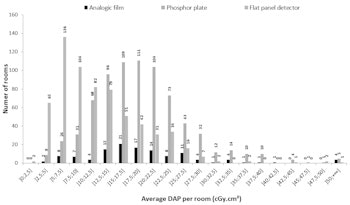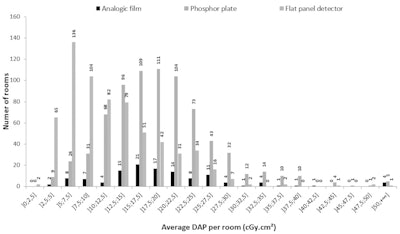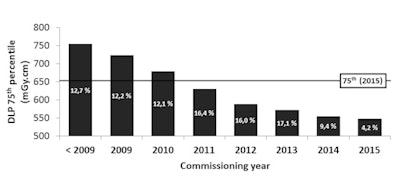
New analysis of national diagnostic reference levels (DRLs) has revealed staff in French x-ray departments tend to drag their heels when it comes to radiation protection, whereas CT professionals are increasingly on board in the DRL process. Strikingly, DRLs must now be updated to reflect lower doses seen across much of clinical practice, the authors said.
The report, published online by the European Journal of Radiology on 8 November and scheduled for inclusion in the January 2018 edition, presented the latest analyses performed on national data from 2013 to 2015. It showed that data were obtained from around 80% of France's 1,100 CT scanners, but only an estimated 30% of the country's 5,100 x-ray departments had complied with the requirement of sending in dose information. The rest needed to catch up, the authors stated.
The study also showed doses collected from clinical practice were at times 40% lower than regulation references in 2015, strongly suggesting the list of examination types and some numerical values should be updated in the regulation.


The two graphs show the relationship between specific factors and patient dose exposure assessed in the DRL evaluation process. Figure 1 shows distribution of the average dose area product (DAP) per room as a function of the detector type (analogic film, phosphor plate, flat panel) for chest PA radiography during the 2013-2015 period. Graphs courtesy of EJR and Patrice Roch and colleagues.
Importantly, significant patient exposure reduction occurred when digital radiography was used and when CT equipment is less than 5 years old, the authors noted.
"The DRLs update should be considered urgent because current DRL values do not match with current practices. As a consequence, the interest of referring to DRLs for dose optimization is very limited," said lead author and medical physicist Patrice Roch, radiation safety expert for medical applications at France's Nuclear Safety and Radiation Protection Institute (Institut de radioprotection et de sûreté nucléaire, IRSN) in Fontenay-aux-Roses.
 CT commissioning date influence on the dose length product (DLP) 75th percentile considering the examination of abdomen-pelvis. Percentages into the graph bars are related to the rate of CTs for each commissioning year. The dark horizontal line represents the 2015 75th percentile of all CT scans.
CT commissioning date influence on the dose length product (DLP) 75th percentile considering the examination of abdomen-pelvis. Percentages into the graph bars are related to the rate of CTs for each commissioning year. The dark horizontal line represents the 2015 75th percentile of all CT scans.Speaking to AuntMinnieEurope.com he revealed an update is now in progress based on the results of his group's work. The update is expected at the beginning of 2018, and will take into account IRSN proposals.
"Many DRL values will be lowered by an average 40% for x-ray and by an average 35% for CT," he noted.
Technical improvements
Roch highlighted that French radiologists have capitalized on dose optimization offered by modern techniques such as CT with iterative reconstruction and flat-panel detectors. He pointed to lumbar spine CT as the only exception to the lowered clinical doses, with dose length product (DLP) data above DRL. This is because in recent years there has been an evolution in clinical protocols that has outpaced the DRL value associated with practices on old-generation CT.
In 2001, the French Radiology Society (SFR) recommended lumbar spine CT only for the last three vertebral disks -- a scan length of about 15 cm. In the latest SFR recommendations from 2013, which factor in the use of new-generation CT, the whole lumber spine should be examined resulting in a scan length of about 25 cm. With this increased scan length, DLP for this examination in clinical practice has increased. This evolution in protocol was facilitated by sequential CT in 2001, and helical CT in 2013, alongside improvements in detectors, reconstruction algorithms, and x-ray tubes.
Yearly requirement
Under French legislation, implemented in 2004, medical imaging departments in France each year must perform patient exposure evaluation from their clinical practice for at least two types of x-ray and two types of CT exam chosen from the regulatory list. These samples are sent via a web-based platform to the IRSN for national assessment. These analyses allow IRSN to estimate how well current DRLs represent current practice in terms of target practice and exams, dosimetrics, and numerical values.
 Radiology staff must keep sending their clinical dose data to IRSN, particularly when they upgrade equipment, Patrice Roch said. Image courtesy of Lucien Lung/IRSN.
Radiology staff must keep sending their clinical dose data to IRSN, particularly when they upgrade equipment, Patrice Roch said. Image courtesy of Lucien Lung/IRSN.Additional analyses are also performed using variables such as detector type and unit commissioning date to evaluate their influence on patient exposure. In the most recent study, x-ray detector type and CT reconstruction algorithms associated with optimized protocols had a positive impact on dose optimization.
Roch explained the gap between DRLs and practice as mainly due to the low frequency of regulation update, which takes place every seven years on average, compared with the rhythm of technical and clinical evolution.
"Performance of devices and dose optimization processes improve faster than DRLs updates. Participation is mandatory in France but some departments do not respect that obligation. The number of departments that send data in each year is a fraction of the overall number of departments," he said, adding that the clinical data was still considered to be representative of national data because the size of the sample was large.
Lower proposals
"Dose data from clinical practice are lower than DRLs and this is very good news for patients. It shows that practices have improved since the last DRLs update in 2011 and that current DRL values have to be updated again," he continued.
The authors from IRSN and radiation protection consultancy CERAP have already submitted proposals for updated examination lists and drastically reduced future DRLs. Definitive DRLs will be published in the coming months.
Compared with the U.K., where dose reduction has been a work in progress for 25 years to achieve a 50% reduction in dose, the 30% to 40% reduction achieved in France over 12 years is encouraging, according to Roch, and, given the newness of the DRL process, comparable with dose reduction in Germany.
He sounded a note of caution, however: Technological advances are not enough to bring about dose reduction, but must be coupled with professional protocol review to optimize patient doses. Use of modern equipment without the right training and procedure review can sometimes lead to dose increase.
"I hope the paper encourages radiologists to continue evaluation and follow-up of patient dose, in particular when they change their equipment," he said.



















